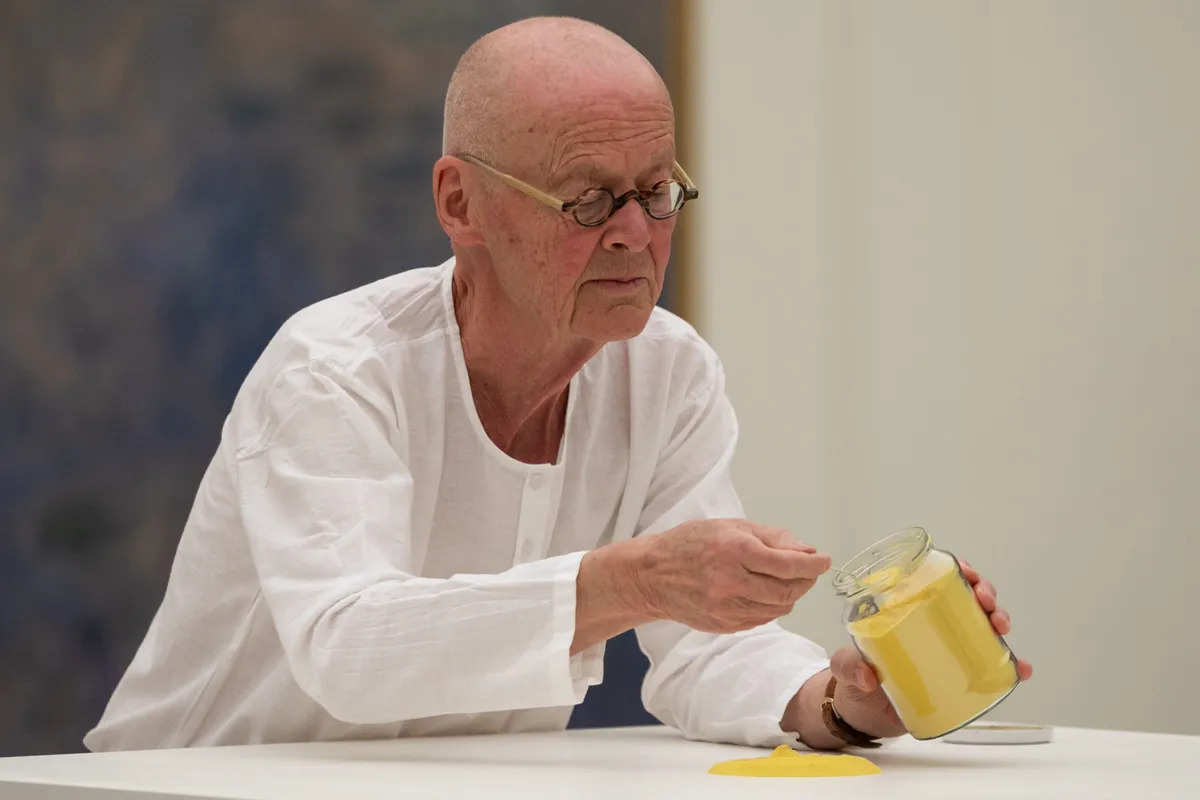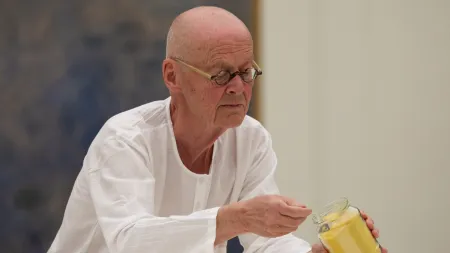
The 1.3 million visitors that come to Paris’s Musée de l’Orangerie every year are primarily drawn to the eight Water Lilies mural paintings that Claude Monet donated to the French State in 1922 and are displayed in a space the artist designed with architect Camille Lefèvre. But earlier this month, in the second of the museum’s two oval rooms, German artist Wolfgang Laib staged an intervention, creating one of his notorious mountains of pollen in front of a captivated audience. The 40-minute performance, in which Laib meticulously sprinkled yellow pollen from a jar onto a waist-high plinth, was part of the museum’s “Counterpoint” program, which has brought the work of contemporary artists into the museum since 2018.
Titled “A Mountain not to climb on. For Monet,” Laib’s exhibition at the Musée de l’Orangerie consists of two impressive installations that bring Impressionism, which is celebrating its 150th anniversary this year, into the 21st century. On the lower level, more than a hundred piles of rice take up the entirety of a small, single room located opposite the permanent artworks and a temporary exhibition gallery currently devoted to Robert Ryman (through July 1). Laib, who represented Germany at the Venice Biennale in 1982, started using rice and wax in 1983, and has kept to the medium, 40 years on, for the sake of consistency. “In the past 50 years, I have experimented new techniques, of course, but not every five minutes. Had Piet Mondrian shifted his practice every other month, no one would look at his art the way they do now,” Laib told ARTnews in a recent interview.
On the first level, past the entrance hall, in an all-white antechamber that leads to Monet’s Water Lilies, a four-inch pyramidal pile of a yellow powdery material sits on a display pedestal. Laib said that Claire Bernardi, the museum’s director, “wanted a pollen piece in connection with Claude Monet. This type of work requires a quiet space.” The pollen on view here is sourced from hazelnut trees, the same kind as the large-scale floor installation he made in 2013 at the Museum of Modern Art in New York. “It is a bit sticky, which allows me to shape it as a mountain. Pollen from pine trees, for instance, is thinner. It would collapse and flow like lava from a volcano,” he added.

Laib has always worked with natural materials in his art-making. It all started with stone. In 1972, he carved his first Brahmanda, an ongoing series of egg-shaped stone sculptures that elegantly rest in the middle of nearly empty rooms. That pursuit led him to study medicine, not to pursue a career as a doctor, but to further his art. A few years later, Laib rose to fame with his Milkstones, slabs of pure white marble sanded down to contain milk.
In 1977, Laib, then an up-and-coming sculptor, began to collect pollen, which he refers to as “the beginning of life,” around his home in Germany. “It fits the way he has been living his whole life”, his wife Carolyn Reep explained during our interview. “The glass house, that his father built near the town of Biberach, stands in the middle of a meadow. He has always been connected to nature.” (The house was inspired by Mahatma Gandhi’s original house at Sabarmati Ashram, in Ahmedabad, India.)
As for rice, “it is food but visually it has a very abstract presence, which I really like,” Laib said. In the context of the Musée de l’Orangerie, some may see rice grains as a physical variation on Pointillism, a branch of Impressionism.

Laib’s relationship to Impressionism and Claude Monet specifically dates back to his teenage years, when his parents took him for the first time around Europe. He remembers seeing a major work by the Impressionist, though all these years later he can’t recall exactly which one. For Laib, it was more the impression the work left on him. Back then, his family had only eyes for Kazimir Malevich and worshipped Constantin Brancusi almost like “a demigod,” he said.
Laib continued, “Making a mountain of pollen in this ocean of waterlilies almost feels like meeting Claude Monet in person. I had the same sensation, the same timeless experience with Fra Angelico in Florence [in 2019].”
There are certainly similarities between the two artists, working decades apart. Like Monet, Laib lives close to nature, to the earth, and enjoys studying plants. Monet’s depictions of poppy fields, urban monuments like Paris’s Gare Saint-Lazare or the Rouen Cathedral, or his personal garden in Giverny are often thought to border on abstraction. And in a way, Laib’s non-figurative works can also be thought of as landscapes. “To me, the visual presence of those rice and pollen mountains is simply beautiful,” he said.

Both artists have also been influenced by Asian art and culture. Monet collected over 200 Japanese prints during his lifetime and constructed a Japanese bridge built in his garden in Giverny, which was also the subject of his final body of work. Laib’s parents were friends with German landscaper Jakob Bräckle, who introduced them to Taoism and Zen Buddhism and ultimately led them to collect Tantric drawings, which reminded them of Mondrian’s aesthetic.
The day of his performance at the Musée de l’Orangerie was the day when Laib was returning to Europe from India, where he has maintained a studio since 2006. He usually spends a couple of months there once or twice a year to work on new projects. “Life in India is not easy. It’s like living on another planet. You learn so much about yourself. It opens your mind to something different,” Laib said.
His Indian studio and home are nothing like the minimalist glass house his father had built in 1960s Germany, though Laib still enjoys visiting it, especially in the spring—the best time to begin harvesting pollen. Before landing in Paris, Laib was working on a new series of Brahmandas in black granite. With his response to Monet’s Water Lilies now behind him, Laib admitted that his absolute dream in the future would be to perform a mountain of pollen on a Brancusi table.
How a City Agency Saves New York’s Discarded Objects for Art
Art Basel’s Latest Collaboration Aims to Put Art in Service of Saving the Oceans

Joseph Eichler’s Personal Silicon Valley Home Is Up for Grabs at $6.4 Million

Beyoncé’s Best Country Looks Through the Years, From Her Destiny’s Child Days to ‘Cowboy Carter’

New tech will let wind turbines build themselves

College Basketball’s Biggest Stars on Social Media Are Women: Data Viz


